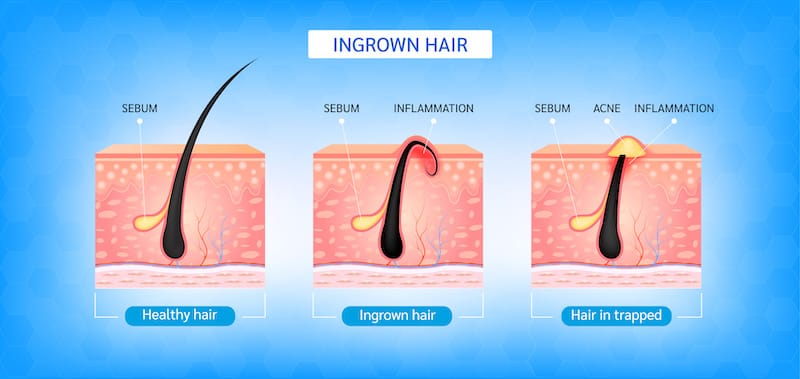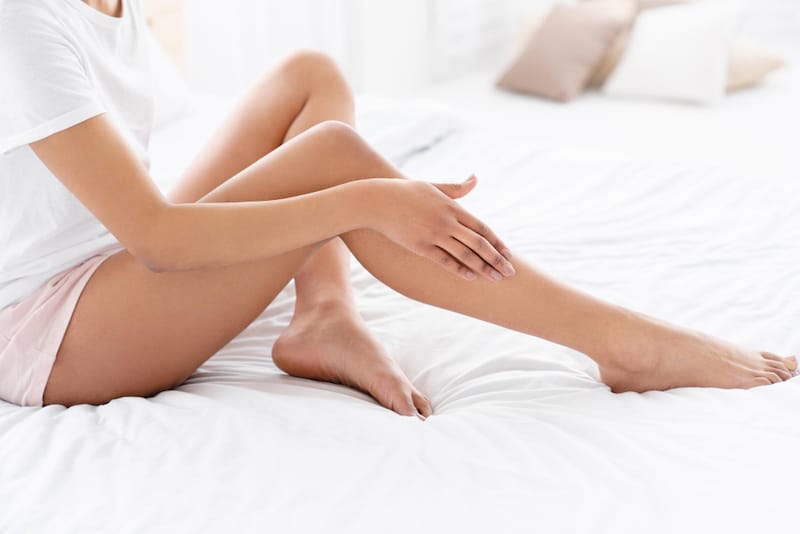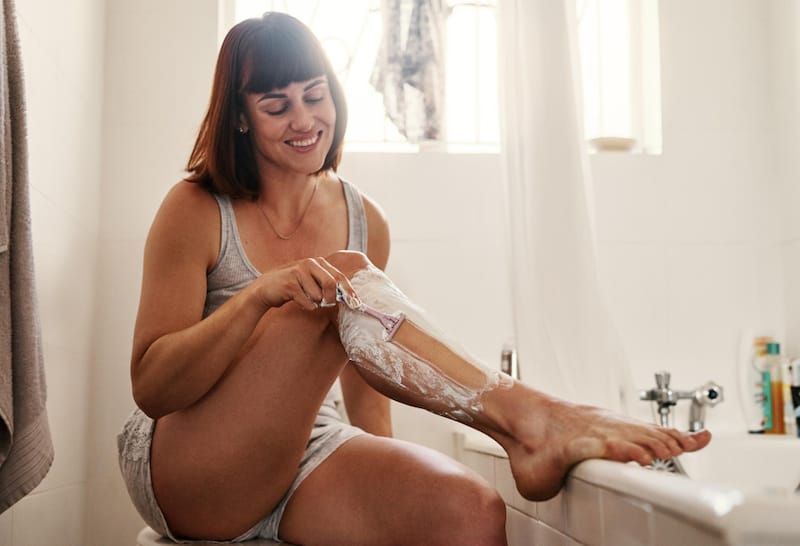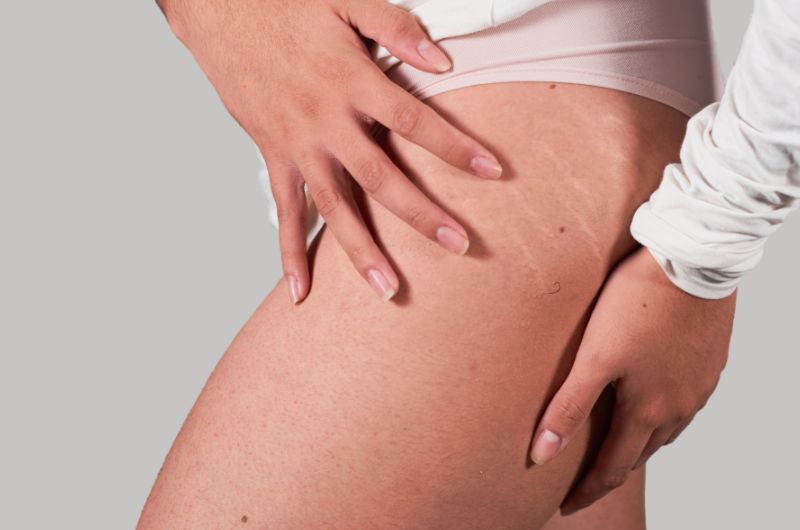Ingrown hair can appear even in your stretch marks. Even though stretch marks don’t produce hair or oils, the scar tissue may be penetrated by the hair around it, thus creating a possibility of ingrown hair.
Ingrown hairs are hairs that curl back into the skin instead of growing out of the skin. Sometimes, they create cysts or raised, red bumps that can be painful to the touch.
People usually get ingrown hairs on their legs, inner thighs, armpits, or pubic regions, wherever they typically shave.
Now, stretch marks are a type of scars, and scars are made of collagen, which does not allow hair to grow, nor does it produce oils.
It’s possible to get ingrown hairs on your stretch marks because the hair follicles around the stretch mark may produce hair that penetrates the scar tissue.
An ingrown hair on your stretch mark is still the same as any other ingrown hair on a different part of your body. Therefore, it may still lead to infection if a bacteria manage to enter.
Symptoms of ingrown hair

The following are the symptoms and signs that you have ingrown hair:
- Itching
- Irritation of the skin
- Small swollen bumps on places where you shave, tweeze, or wax
- Stinging pain
- Discolored bumps
What can cause ingrown hair?
Here are the leading causes of ingrown hair:
1. Structure and growth direction
The structure of your hair follicle and the direction of hair growth are believed to be one of the causes of ingrown hair.
For example, tightly curved hairs have curved hair follicles. This encourages the hair to curl back into the skin.
2. Shaving, tweezing, and waxing

When you shave, you create sharp edges on your hair. This makes it easier for hair to pierce the skin once it tries to curl downwards.
Also, when you pull at your skin while you shave, your hair draws back into the skin.
3. Trapped hair
Sometimes a hair can get trapped under the skin before it can grow out. This can cause cysts because the trapped hair clogs your pore, irritating the skin.
What are my treatment options for ingrown hair?
Ingrown hairs, and sometimes an accompanying cyst, often go away without needing treatment. Home remedies are also available if you want to eliminate inflammation or reduce the risk of infection.
- Keep It Clean – Wipe the area with clean water to keep your cyst or ingrown hair clean. You should make sure that the area is clean at all times.
- Warm Compress – Apply a warm compress on the area for 10-15 minutes a few times throughout the idea. This opens your pores and helps the cyst go closer to the surface so that it can drain. This is especially helpful to those with hair trapped underneath the skin.
- Stop Shaving – Don’t shave for a while so that the ingrown hair has a chance to grow out.
- OTC medications – Over-the-counter medicines with retinoids or benzoyl peroxide help reduce inflammation and the cysts’ size.
- Apply an antiseptic solution – Tea tree oil helps reduce the risk of infection.
When should I see a doctor for my ingrown hair?
Usually, an ingrown hair and cyst clear up on their own.
However, there are times that they don’t. Sometimes the cyst can be too painful, or you develop an infection.
Seek professional help if:
- The cyst becomes too painful
- There is an increased redness of the cyst
- The cyst is oozing out pus or fluid that has a foul smell
- You develop a fever
- Your cyst is preventing you from doing your daily activities
What not to do
When your ingrown hair develops a cyst, it is important not to pop or pick at it.
Even if it releases the liquid inside it (which is keratin), the cyst can still grow back.
A popped cyst may also increase the risk of infection due to bacteria getting into the torn skin.
Tips to prevent ingrown hair
If you want to prevent ingrown hairs, you should completely stop any hair removal methods. However, if that is not an option for you, you can try the following:

- Use aftershave and shaving cream to help soothe your skin
- Use only sharp razors
- Do not shave irritated or red skin
- Only shave in the direction in which your hair grows
- You should exfoliate dull and dry skin
- Moisturize after each shave
Who is at risk of ingrown hair?
People who pluck, shave, or wax their skin are at higher risk of developing ingrown hairs. This is because any hair removal method, especially shaving, makes the hair sharp and thus allows it to pierce the skin easily.
People who have dull and dry skin are also at risk. Dead skin can accumulate on your pores and clog them, trapping the hair underneath.
People who have coarse, thick, curly hair. They are also at higher risk of ingrown hair because curled follicles make it more likely for hair to grow downward and pierce the skin.
FAQs
How can I tell if a bump is an ingrown hair?
Sometimes you can see the trapped hair underneath the skin. A bump is also possibly ingrown hair if the skin around it is darkening or the bump starts to fill with pus.
If the bump is also itchy or painful, this may also be a sign of it being an ingrown hair.
What causes chronic ingrown hair?
You might get ingrown hairs constantly because of improper shaving. For example, you might be using a dull razor, or the direction in which you shave is not the direction of your hair growth.
To treat this, you should let your hair grow back longer and change your hair removal method.
You can also try applying shaving creams and soothing gels to help reduce the risk of your skin getting irritated.
Conclusion
Even though stretch marks are scars, which typically should not develop any hairs and therefore cause ingrown hairs, it is still possible.
This is because the hairs around the stretch mark can penetrate the scar tissue. Therefore, you should never pop a cyst for any reason. This increases the risk of infection and, eventually, a scar.
Ingrown hairs can be prevented if you stop shaving, tweezing, or waxing.
However, if that is not possible, you should ensure a proper shaving routine to avoid ingrown hairs.
It’s also important to seek medical help if you develop an infection, if a cyst does not clear up or if it prevents you from doing your daily activities.


